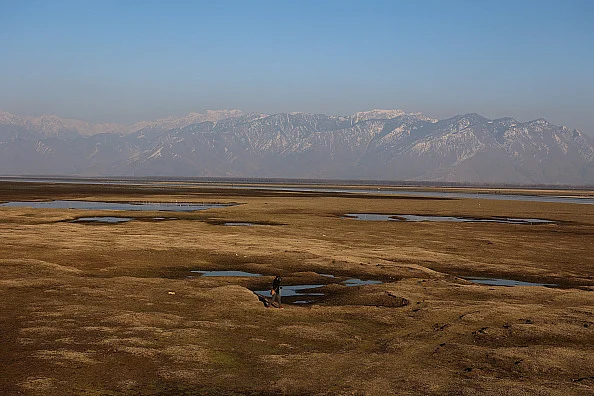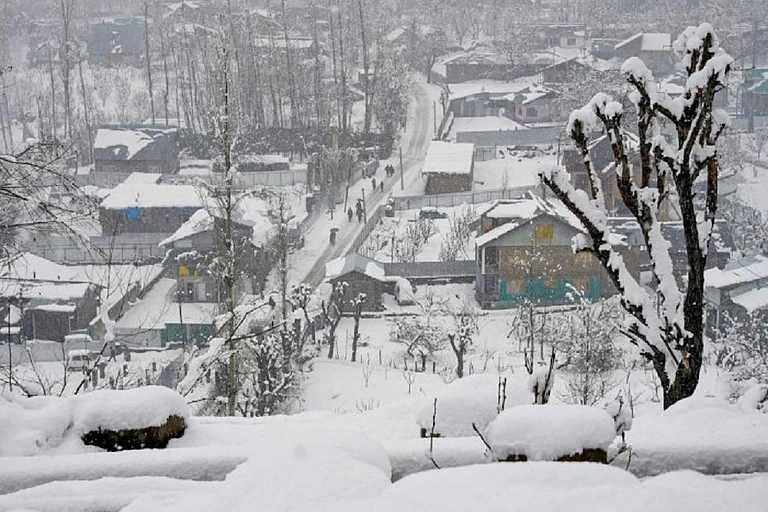Jammu and Kashmir has been receiving hefty rain and snow lately. While this recent precipitation might seem promising to many, it is merely an illusion. The statistical reality is telling a different tale altogether.
This winter has brought forth a formidable challenge: a rainfall deficit of 54 per cent, surpassing even the deficits witnessed in the previous years. Between December and February, J&K received 129.7 mm of rainfall against an expected rainfall of 284.9 mm. January experienced the most severe shortfall, with a staggering deficit of 91 per cent, followed by December at 79 per cent and February at 17 per cent.
The impact of this shortfall was particularly severe in Shopian and Kathua districts with deficits reaching 82 per cent and 83 per cent respectively. Jammu wasn't far behind with a deficit of 72 per cent. Other districts such as Ganderbal, Kulgam, Reasi, Samba, and Udhampur experienced deficits ranging from 60 per cent to 70 per cent. Srinagar, Anantnag, Budgam, Kupwara, Pulwama, Doda, and Ramban recorded deficits between 40 per cent and 60 per cent. Rajouri faced a deficit of 36 per cent, Bandipora 37 per cent, and Baramulla 29 per cent. The data for Poonch and Kishtwar districts was unavailable.
How is the condition compared to previous years?
Comparing the current conditions with previous winters reveals a troubling trend.
In winter 2022-23, J&K witnessed a rainfall deficit of 34 per cent, with December and February bearing the brunt of 78 per cent and 69 per cent deficits respectively. January, however, recorded a 42 per cent surplus.
The winter of 2021-22 fared slightly better with a deficit of just 9 per cent, although December and February saw deficits of 74 per cent and 41 per cent respectively, offset by a substantial surplus of 81 per cent in January.
Winter 2020-21 recorded a deficit of 37 per cent, with February experiencing the highest shortfall at 73 per cent, followed by December at 9 per cent and January at 6 per cent. In the winter of 2019-20, J&K faced a deficit of 20 per cent, while the winter before that recorded a surplus rainfall of 34 per cent.
The current 54 per cent deficit marks the highest shortfall in the past five winters, underscoring the growing vulnerability of the region to changing weather patterns. However, there may be some silver linings amidst the gloom. Unlike previous years where precipitation was concentrated in January or December, this winter saw substantial snowfall in February.
Moreover, temperatures in February remained near or below normal in most areas. Consequently, snow retention was notably better this winter, in contrast to previous years when warmer-than-average February temperatures and spring warmth led to rapid snowmelt. March has also shown promising signs this year with regards to rainfall and snowfall. Despite these positive developments providing some relief, the overall situation remains delicate. The substantial 54 per cent deficit emphasises the pressing necessity to tackle climate change and global warming urgently.
The implications of this deficit are profound, impacting not only agriculture but also extending to crucial aspects such as ecological balance, water resource management, and the livelihoods of millions who depend on these resources. Glaciers, vital sources of freshwater, are dwindling at an alarming rate, exacerbating the challenges posed by climate change.
To effectively address this pressing issue, concerted efforts at both local and global levels are imperative. Mitigation strategies, including transitioning to renewable energy sources, reducing carbon emissions, and implementing sustainable land management practices, are critical in mitigating the impacts of climate change. Additionally, adaptation measures, such as improving water management systems, enhancing infrastructure resilience, and prioritising disaster preparedness, are essential for navigating the complexities of a changing climate.
Recognising the interdependence of agriculture, ecology, and society in addressing climate change must be a top priority for all stakeholders. Only through collaborative action can we mitigate the adverse effects of climate change and safeguard the future of our planet and its inhabitants.
The author is an independent weather forecaster, also known by ‘Kashmir Weather’ across social media platforms.





















